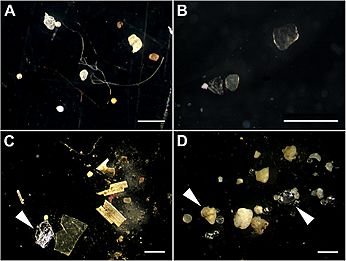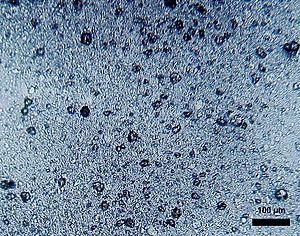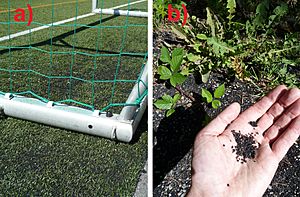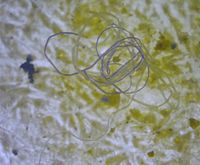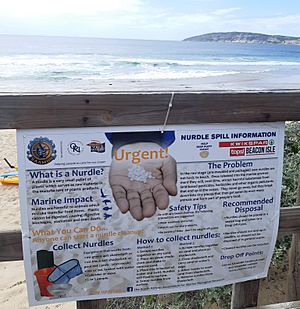Microplastics facts for kids
Microplastics are fragments of any type of plastic less than .195 in (5.0 mm) in length, according to the U.S. National Oceanic and Atmospheric Administration (NOAA) and the European Chemicals Agency. They cause pollution by entering natural ecosystems from a variety of sources, including cosmetics, clothing, food packaging, and industrial processes.
Micro means "small" and Macro means "large," so the term macroplastics is used to show the difference between microplastics and larger plastic waste like plastic bottles. There are two classifications of microplastics:
- Primary microplastics include any plastic pieces (fragments) or particles that are already .195 inch or smaller before entering the environment.
- Secondary microplastics are former macroplastics that have degraded (broken down) after entering the environment.
Both types of microplastics exist in the environment at high levels, mostly in aquatic and marine ecosystems, where they cause water pollution. However, microplastics also gather in the air and terrestrial ecosystems.
Because plastics degrade slowly, microplastics have a high chance of being ingested and accumulated into living organisms. The toxic chemicals that come from the ocean and runoff can travel up the food chain. In soil, microplastics have been seen to damage soil and reduce the weight of earthworms. Microplastics have been found in layers of soil that are older than the invention of plastics. They have also been found in the high mountains, quite far away from their source.
Microplastics have also been found in human tissue and in human blood. Scientists do not yet know how this affects people.
Contents
Classification
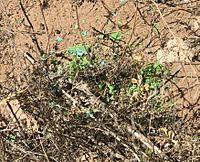
The term "microplastics" was introduced in 2004 by Professor Richard Thompson, a marine biologist at the University of Plymouth in the United Kingdom.
Microplastics are common in our world today. In 2014, it was estimated that there are between 15 and 51 trillion individual pieces of microplastic in the world's oceans, which were estimated to weigh between 102,514 and 260,145 tons.
Primary microplastics
Primary microplastics are small pieces of plastic that are made to be small. They are called "microbeads" or "scrubbers." They are usually used in hand or facial cleansers and cosmetics, in air blasting technology, or in pharmaceutical drugs. Microplastics have replaced natural ingredients like ground almond shells, oatmeal, and pumice in skincare. Air blasting is blasting acrylic, melamine, or polyester microplastic scrubbers at machinery, engines, and boat hulls to remove rust and paint.
Secondary microplastics
Secondary microplastics are small pieces of plastic that are a result of the breakdown (fragmentation) of larger plastic litter. The smallest piece of microplastic reported in the oceans is 6.3×10−5 in (1.6 micrometers) in diameter. It is believed microplastics with uneven shapes are caused by fragmentation.
Other sources: as a by-product/dust emission during wear and tear
There are countless sources of both primary and secondary microplastics. Microplastic fibers enter the environment from the washing of synthetic clothing. Tires, made partly of synthetic styrene-butadiene rubber, will erode into tiny plastic and rubber particles as they are used.
Nanoplastics
Depending on the definition used, nanoplastics are less than 1 μm (i.e. 1000 nm) or less than 100 nm in size. Some scientists believe that nanoplastics are a temporary byproduct during the fragmentation process of plastics. Others believe that nanoplastics are an invisible threat that will continue to get worse over time.
Nanoplastics are thought to be a risk to environmental and human health. Due to their small size, nanoplastics can cross cell membranes and affect the functioning of cells. Little is known about the negative health effects of nanoplastics in humans. However, studies and data have shown that when fish absorb them, their stress levels, growth, and reproduction are negatively affected.
Potential effects on the environment
In 2019, the European Union's Scientific Advice Mechanism published a review of scientific evidence showing that microplastics are now present in every part of the environment. They estimate that microplastic pollution will become widespread within a century if pollution continues the way it is going now.
So far, scientific research has mainly focused on larger plastic items. Marine animals can become tangled in, eat, or be suffocated by plastics in the ocean. In contrast, microplastics are not as obvious. They are usually invisible to the naked eye and affect more species of organisms. Toxicity debt, the release of toxic compounds into the environment when plastics decay, has not been studied either.
Microplastics have been found not just in marine but also in freshwater systems including marshes, streams, ponds, lakes, and rivers in (Europe, North America, South America, Asia, and Australia). Samples collected across 29 Great Lakes tributaries from six states in the United States were found to contain plastic particles. 98% of those particles were microplastics ranging in size from 0.0139 to 0.187 in.
Biological integration into organisms
Microplastics can become embedded in animals' tissue through ingestion (eating or drinking) or respiration (breathing). Scientists have found microplastics in the gastrointestinal tracts, respiratory tracts, and digestive tracts of sea animals. It can take up to 14 days for microplastics to pass through an animal (compared to the normal digestion period of 2 days). This affects larger animals (like tuna and swordfish) that eat the smaller animals. The smaller animals are sometimes fooled into thinking they have had enough food and suffer starvation or other physical harm from the microplastics.
In 2017, marine biologists discovered that three-quarters of the underwater seagrass in the Turneffe Atoll off the coast of Belize had microplastic fibers, shards, and beads stuck to it. Seagrass is part of the barrier reef ecosystem and is fed on by parrotfish, which in turn are eaten by humans.
Zooplankton ingest microplastic beads (1.7–30.6 μm) and excrete fecal matter contaminated with microplastics. The microplastics also stick to the appendages and exoskeleton of the zooplankton.
Not only do animals and plants ingest microplastics, but some microbes also live on the surface of microplastics. This community of microbes forms a slimy biofilm. These microplastic biofilms have been shown to provide a perfect habitat for the colonization of pathogens and antibiotic resistant genes that can spread through water.
It is not just aquatic animals that may be harmed. Microplastics can stunt the growth of terrestrial plants (plants grown in soil) and earthworms. In 2019, microplastic items were found in the stomachs of the common European newt (Triturus carnifex).
Humans
According to a comprehensive review of scientific evidence published by the European Union's Scientific Advice Mechanism in 2019, "little is known with respect to the human health risks of nano- and microplastics, and what is known is surrounded by considerable uncertainty." This means that scientists are not sure how much microplastics it would take to poison a human. Scientists are continuing their research in this area.
Buoyancy
Approximately half of the plastic material brought to a marine environment is buoyant. Sometimes it can sink to the sea floor when it degrades or is digested by animals. Microplastics can also form a buoyant biofilm layer on the ocean's surface. The density of the plastic and the size and shape of the fragments themselves contribute to the microplastic's buoyancy.
| Plastic Type | Abbreviation | Density (g/cm3) |
| Polystyrene | PS | 1.04-1.08 |
| Expanded Polystyrene | EPS | 0.01-0.04 |
| Low-density Polyethylene | LDPE | 0.89–0.93 |
| High-density Polyethylene | HDPE | 0.94-0.98 |
| Polyamide | PA | 1.13-1.16 |
| Polypropylene | PP | 0.85-0.92 |
| Acrylonitrile-butadiene-styrene | ABS | 1.04-1.06 |
| Polytetrafluoroethylene | PTFE | 2.10-2.30 |
| Cellulose Acetate | CA | 1.30 |
| Polycarbonate | PC | 1.20-1.22 |
| Polymethyl methacrylate | PMMA | 1.16-1.20 |
| Polyvinyl chloride | PVC | 1.38-1.41 |
| Polyethylene terephthalate | PET | 1.38-1.41 |
Where microplastics can be found
Steve Allen of Dalhousie University in Canada, the main author of a study that found microplastics in high mountains, said, "Plastic leaving the ocean into the air that high – it shows there is no eventual sink for this plastic. It's just moving around and around in an indefinite cycle."
Oceans
Ice cores
Scientists found 96 microplastic particles from 14 different types of polymers in an ice core tested in 2009 from east Antarctica. Plastic pollution has previously been recorded in Antarctic surface waters and sediments as well as in Arctic sea ice, but this is thought to be the first time plastic has been found in Antarctic sea ice. Relatively large particle sizes suggest that the pollution came from nearby.
Freshwater ecosystems
Microplastics have been widely found in the world's aquatic environments. The first study on microplastics in freshwater ecosystems was published in 2011. It found fragments in Lake Huron's sediment samples. Since then, MP (microplastics) have been found in all the Great Lakes. They have also been discovered in Lake Winnipeg and the Rhine, a major river in Europe.
Soil
Although most microplastic research has been done in aquatic environments, a large portion of microplastics is expected to be found in the world's soil. Scientists believe that fibrous secondary microplastics from washing machines could end up in soil through the failure of water treatment plants to completely filter out all of the microplastic fibers. Further research, however, is needed.
Human body
Microplastics find their way into the food we eat, the water we drink, and even the air we breathe. Some scientists estimate that people consume more than 50,000 plastic particles per year – and many more if inhalation is considered. Microplastics were found in every human tissue studied by graduate students at Arizona State University. Microplastics have also been found in blood, meaning they can be transported around the human body. This makes scientists wonder if they can also be transported to the brain. In December 2020, microplastic particles were found in the placentas attached to unborn babies.
Plastic pollution is having the greatest negative impact on the world’s poorest populations. Plastic pollution directly and indirectly threatens their human rights, including the rights to life, health, water and sanitation, food, housing, culture, and development.
Air
Airborne microplastics have been detected in the atmosphere, as well as indoors and outdoors. A 2007 study found that there are microfibers indoors. In 2019, a study found that the wind atmospherically transported microplastics. Microplastics have been found in street dust and snow samples. However, much like freshwater ecosystems and soil, more studies are needed to understand the full impact of airborne microplastics.
Proposed solutions
Incineration and biodegradation
Some researchers have suggested incinerating plastics to use as energy, which is known as energy recovery. However, as opposed to recycling, this method does not reduce the amount of plastic material that is made. Therefore, recycling plastics is considered a more efficient solution.
Biodegradation is another possible solution to large amounts of microplastic waste. In this process, microorganisms consume and decompose synthetic polymers by using enzymes. These plastics can then be used in the form of energy and as a source of carbon once broken down. The microbes could be used to treat sewage wastewater, which would decrease the number of microplastics that pass through into the surrounding environments.
Filtering
Stormwater or wastewater collection systems can capture many microplastics which are transported to treatment plants. The captured microplastics become part of the sludge produced by the plants. This sludge is often used as farm fertilizer, meaning the plastics enter waterways through runoff.
Fionn Ferreira, winner of the 2019 Google Science Fair, is developing a device for the removal of microplastic particles from water using a ferrofluid.
Collection devices
Computer modeling done by The Ocean Cleanup, a Dutch foundation, has suggested that collection devices placed nearer to the coasts could remove about 31% of the microplastics in the area.
In addition, some bacteria have adapted to eat plastic, and some bacteria species have been genetically modified to eat (certain types of) plastics.
Education and recycling
Spreading the word about recycling is another suggested solution for microplastic contamination. If recycling efforts are increased, less plastic would be made.
Action for creating awareness
Various agencies and organizations have tried to bring awareness to microplastic pollution.
- On April 11, 2013, Italian artist Maria Cristina Finucci founded The Garbage Patch State under the patronage of UNESCO and the Italian Ministry of the Environment.
- The U.S. Environmental Protection Agency (EPA) launched its "Trash-Free Waters" initiative in 2013. It also funded projects in the San Francisco Bay Area.
- The EPA works with the United Nations Environment Programme–Caribbean Environment Programme (UNEP-CEP) and the Peace Corps to reduce and also remove trash in the Caribbean Sea.
- Florida Microplastic Awareness Project (FMAP) is a group of volunteers who search for microplastics in coastal water samples.
- The United Nations Sustainable Development Goal 14 hopes to prevent and reduce all forms of marine pollution by 2025.
Funding
The Clean Oceans Initiative is a project launched in 2018 by the public institutions European Investment Bank, Agence Française de Développement, and KfW Entwicklungsbank. The organizations will be providing over $2 billion in lending, grants, and technical assistance until 2023. Their goal is to develop projects that remove pollution from waterways (with a focus on macroplastics and microplastics) before it reaches the oceans.
Policy and legislation
With more people becoming aware of microplastic pollution, groups are now asking for the government to make laws that will make companies make their products without microplastics. These environmental groups will keep pressuring companies to remove plastics from their products to maintain healthy ecosystems.
China
In 2018, China banned the import of recyclables from other countries, forcing those other countries to re-examine their recycling schemes. Scientific American reported that China dumps 30% of all plastics in the ocean.
United States
In the U.S., laws are beginning to take effect that lessen the negative environmental effects of microplastics. Illinois was the first US state to ban cosmetics containing microplastics. President Barack Obama signed the Microbead-Free Waters Act 2015, which pans "rinse-off" cosmetic products that contain microplastic beads. On June 16, 2020, California adopted a definition of "microplastics in drinking water."
On July 25, 2018, a microplastic reduction amendment was passed by the U.S. House of Representatives. The legislation, as part of the Save Our Seas Act designed to fight marine pollution, aims to support the NOAA's Marine Debris Program. President Donald Trump signed the re-authorization and amendment bill into effect on October 11, 2018.
Japan
On June 15, 2018, the Japanese government passed a bill to reduce microplastic production and pollution, especially in aquatic environments.
European Union
The European Commission assigned a Group of Chief Scientific Advisors to review the scientific evidence of microplastic pollution through the EU's Scientific Advice Mechanism. The commission will consider whether European policies should be changed to lessen microplastic pollution.
In January 2019, the European Chemicals Agency (ECHA) proposed to ban microplastics that are intentionally added to products.
The European Commission's Circular Economy Action Plan wants to require the recycling of important products like plastic packaging. The European Commission wants to try to reduce the release of secondary microplastics from tires and textiles. They also plan to update the Urban Waste Water Treatment Directive to protect the environment from industrial and urban wastewater release. A change to the EU Drinking Water Directive was temporarily approved to guarantee microplastics are regularly monitored in drinking water.
United Kingdom
The Environmental Protection (Microbeads) (England) Regulations 2017 ban the production of any rinse-off personal care products (such as exfoliants) containing microbeads. This particular law lists specific penalties when it is not obeyed. Those who do not comply are required to pay a fine. If they do not pay the fine, they may receive a notice to stop production. If they do not stop production, they can be criminally charged.
Interesting facts about microplastics
- Companies started putting microplastics called microbeads in beauty products because it was cheaper than using natural ingredients.
- Recent studies found that 83% of metropolitan tap water contained forms of plastic pollutants.
- Eleven of the world’s largest bottled water brands were tested for microplastics. The results showed that 93% of bottled water contained microplastics.
- An average person drinking three regular cups of tea or coffee daily, in a paper cup, would be swallowing 75,000 tiny microplastic particles. That's a good reason to use a mug.
- The U.S. and the UK are producing more plastic waste per person than any other major country.
- Each year, about 1 million tons of tiny plastic fibers are released into wastewater.
- A single fleece jacket sheds up to 250,000 microfibers during a single wash.
- The average person consumes 0.176 ounces of plastic per week.
See also
 In Spanish: Microplástico para niños
In Spanish: Microplástico para niños
- Citizen Science, cleanup projects that people can take part in.
- Plastic soup


